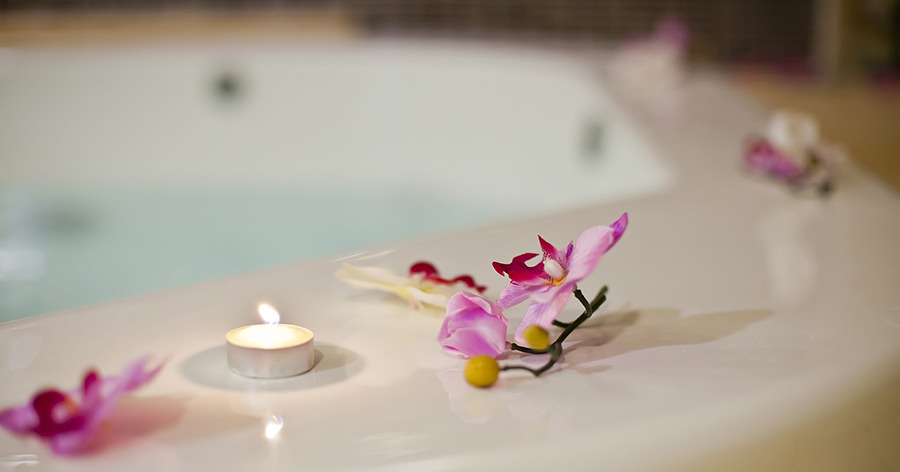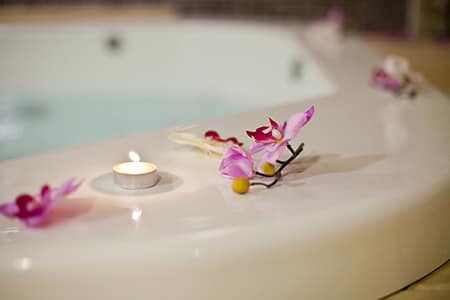
Is there anything more relaxing than a dip in the hot tub? How about a dip in a hot tub with a bath bomb? But is it safe to use bath bombs in a hot tub, or will it cause some kind of damage? I decided to find out more.
So, Can I Use Bath Bombs in a Hot Tub? Yes, you can technically use bath bombs in a hot tub, but there are some precautions that you’ll need to take. For a start, you should never use any kind of fizzing bath bomb or bath product which contains confetti, glitter or flower petals. These could cause damage to the workings of your hot tub.
What should you know about how to choose the right bath bombs to use in your hot tub? And how do you make sure that you aren’t causing any damage to your tub? It needn’t be difficult to enjoy the luxury of using bath bombs for a little extra relaxation, but you need to know which rules to follow.
Choosing the Right Bath Bombs For Your Tub
Bath bombs have become very popular in recent times thanks to the luxurious bathing experience that they offer. Helping you to feel as if you’re in a spa in your very own bathroom, these hard-packed bomb-shaped bath treats contain a mix of ingredients and start to fizz when they are placed in the water. This is very appealing in any kind of bath, but when added to the water jets in a hot tub, they offer an irresistible possibility.
While the idea of using a bath bomb in a hot tub is an attractive one, some people say that you shouldn’t use bath bombs in your hot tub at all to avoid the risks associated with them. After all, bath bombs contain salt which won’t dissolve fully in water. Some of that salt could clump together and could therefore end up clogging the drain and causing a problem which would be difficult to clean up. Also, bath bombs which contain essential oils could be problematic since those oils may solidify once the temperature has dropped and cause drain clogging. To further add to the problems, the non-salt ingredients of bath bombs such as flower petals and glitter can compound the issues, sticking to the tub and pipes and causing possible plumbing issues. When all of this is taken into account, it isn’t too surprising that some people decide it isn’t worth the risk of using a bath bomb in your hot tub.

Yet, while it appears that bath bombs should be a complete no-no when using your hot tub, in fact it is possible to indulge as long as you take some simple precautions. You should certainly avoid using fizzing bath bombs which are loaded with confetti, glitter or other materials. While those additional materials can make the bath tub look lovely and smell great, they can be very damaging for hot tub jets. The particles can cause clogging which can result in a malfunction or complete breakdown.
To avoid having to pay for an expensive repair or even a brand new hot tub, it’s best to also use a fabric bag or nylon stocking wrapped around the bath bomb when dropping them into the tub. This traps all the particles effectively and stops them from getting into the water to clog the jets and pipes. It also won’t prevent the fizz from passing through so you can still enjoy your indulging and relaxing bath to the max.
If I Use a Bath Bomb in my Hot Tub, How do I Clean Up Afterwards?
If you do decide to use a bath bomb in your hot tub, you’ll need to take extra care when it comes to cleaning the tub afterwards. You’ll need to get rid of the oil and salt left behind to prevent a build-up from occurring and making the tub, pipes and jets dirty and clogged. The best idea is to use bath bombs only just before you are planning to do a complete water change on your hot tub. Use a flushing solution to remove dirt and debris from the pipework and then leave the jets running for 20 minutes to dislodge everything into the water. After draining the hot tub thoroughly clean the shell with a hot tub shell cleaning solution and make sure that it is spotlessly clean before rinsing down with clean fresh water.
How do I Clean the Jets After Using a Bath Bomb in my Hot Tub?
If the jets of your tub have noticeable clogging and debris after using a bath bomb, it’s important to take the time to clean them out before using your tub again. Fail to do this, and you can end up with a serious build-up problem that could cause functioning problems or even a total mechanical breakdown of your tub’s inner workings. The best way to clean out the jets is to use an old toothbrush. Use it to scrub carefully around the inside of the jets to remove any visible dirt and grime. This will help to prevent a problem from occurring.

Can Bath Bombs Stain a Hot Tub?
When you’re choosing the right bath bomb to use in your hot tub, you might want to consider the possibilities of staining. Not all bath bombs will stain tubs, but some may contain colors which could pose a staining risk. Bath bombs are made of baking soda, which won’t stain in itself. In fact, baking soda is an ingredient which is regularly used in cleaning products. However, certain brands of bath bomb will contain natural colors which could end up leaving colored rings around the side of the tub. This should be easy to remove if done straight after bathing. Use a microfibre soft cloth and avoid using harsh cleaning products. If you wait for several uses before cleaning away this colored residue, you may find it much harder to wipe away since the colour builds up with repeated use. Even in this situation, use of a regular cleaning product together with some scrubbing on your part should remove the stain relatively quickly.
Can I Use a Bath Bomb Every Time I Use My Hot Tub?
It isn’t a wise idea to use a bath bomb every time you use your hot tub, even if you choose the variety which doesn’t contain any glitter, petals or other materials. This is because this will cause the build up of salt and oils to occur more quickly and increase the chance of damage occurring. Not to mention the fact that it will result in you having to carry out a thorough clean of your tub and the jets much more frequently which will be a time-consuming and laborious task. You should therefore try to only use one before you are planning to do a full drain and clean of your hot tub.
Related Questions
Do they make bath bombs designed specifically for use in hot tub? There are actually a few manufacturers out there who make bath bombs which have been specifically designed for use in hot tubs. These fizz just like a regular bath bomb but won’t cloud the water, color it, or leave oily residues behind. They don’t contain any of the potentially damaging components like flower petals or glitter which could be harmful to a hot tub’s inner workings. This means you can enjoy all of the fun of using a luxurious bath bomb in your hot tub without any concerns or worries about causing damage. There are more brands of these spa-safe bath bombs on the market being released all the time and with countless different aromas to pick from it’s easy to enjoy a spa-like experience without any of the associated problems.
Are bath bombs safe to use at all? There have been some media stories about people who have ended up in hospital after using bath bombs and having a dangerous reaction to the ingredients, so are bath bombs actually safe to use at all, let alone in hot tubs? The answer to this question is yes, at least with certain precautions. It’s important to make sure that you know which ingredients are in your bath bomb and which are safe for use. Bath bombs are made from a mix of citric acid and baking soda which cause the fizzing when it makes contact with the water. These are both safe ingredients, it’s the other additions which could be potentially harmful. Usually, the essential oils and moisturising ingredients which are added to bath bombs are also perfectly safe as are the food grade food colourings and synthetic fragrances which are often found in bath bombs. Nevertheless, it’s important to check the ingredients on the package before using a bath bomb to make sure that it contains nothing which could cause an adverse reaction.

